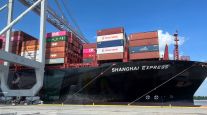April Truckload Shipments Rise
This story appears in the June 9 print edition of Transport Topics.
Truckload carriers’ freight volumes accelerated in April, rising 4.6% compared with last year, and recorded a sequential improvement of 3.7%, which was a two-year high, American Trucking Associations reported.
ATA’s monthly report, made available to Transport Topics last week, reflected gains for dry van carriers with $30 million or more in revenue as well as a 10.8% year-over-year rise in tank truck freight and 2.5% for flatbed freight, both on a sequential basis.
Bob Costello, ATA’s senior economist, attributed the gain to an improving economy.
“Dry van was good,” he told TT on June 4. “I am most pleased about that because that reflects the broadest part of the economy, and that trucking sector had not been performing very well.”
“There was a nice gain, but we are still not back to where we were in November,” Costello said, referring to a month when tonnage and load levels peaked.
Other truckload sectors showed a mix of performance.
Shipments rose 10.8% on a month-to-month basis and 4.8% year-over-year for tank trucks, whose volume has been buoyed by energy exploration.
“Tank truck was gangbusters,” Costello said. “After three surprisingly cruddy months due to weather, they snapped back in April. They have been the real stars of the trucking industry over the past few years.”
Flatbed loads improved on a year-over-year basis for the first time this year, Costello said.
Refrigerated freight was 4.1% higher compared with last April and down 2.5% from March, reflecting a seasonal move, the ATA official said.
Small truckload fleets, with annual revenue below $30 million, did not fare as well and continued a trend of weakening business. They lost 2.1% of volume from March and 5.6% when measured against April of last year.
The report also noted improving trends in the smaller less-than-truckload category with a 0.3% sequential improvement and an 8.9% year-over-year rise. Truckload is about eight times larger than LTL by revenue.
Multiple sources, including carriers, load board operators, the Federal Reserve and analysts also reported improving conditions.
Clifton Parker, CERO of G&P Trucking, and Brian Kinsey, CERO of Brown Integrated Logistics, both told TST freight volumes have been running ahead of last year and that recent shipment levels have been steady.
“We are busy. Capacity is still tight. There are a lot of people looking for trucks,” said Parker, whose South Carolina-based company handles beverage traffic as well as home improvement and automotive freight.
He also said that volumes remained level from March through May, though there was one more operating day in April.
“Business is very steady,” said Kinsey, whose Atlanta-area trucking company serves a different market than G&P.
Kinsey, whose company ranks No. 99 on the for–hire TT100, said dedicated trucking business has “improved pretty significantly year-over-year.”
The steady volumes “are an indication that manufacturers are producing at a pretty steady rate — it is not a yo-yo effect,” Brown said.
While manufacturers are doing better, plants still are running at less than full capacity, he said.
Landfast System, No. 9 on the for-hire TT100, reported stronger freight volumes during a June 2 conference call.
On the load boards, DALT said May spot loads were 48% higher than the same month of 2013, after a 58% year-over-year increase in April.
Internet Truck Stop’s June 2 report said its market demand index, which measures available loads and trucks, strengthened in late May.
The Federal Reserve’s Beige Book report last week said that cargo volume was increasing in line with moderate economic improvement from late April to early May.
Likewise, research firm FRI said last week: “The environment for carriers remains very positive, with rising prices and tight TIL hauling capacity.”
Jonathan Starks, director of transportation analysis, said the firm’s April trucking conditions report reflected the abnormal market earlier in the year, when winter conditions disrupted deliveries and likely caused a drawdown in inventories.
“Freight remains fairly busy,” BB&T Capital Markets analyst Thom Albrecht said in a June 2 investor note. “But the month of May was more pedestrian compared to the often chaotic descriptions from mid-November through April.”
Albrecht said Memorial Day holiday freight patterns were smoother than in recent years and “orderly, with minimal service failures,” based on comments from fleets.
While tonnage and shipment levels both improved in April, ATA’s Costello cautioned that the two indicators of trucking activity don’t always move in tandem.
One reason for that is the difference between weights hauled in freight categories, such as heavy tank truck cargo and typically lighter truckload freight.




